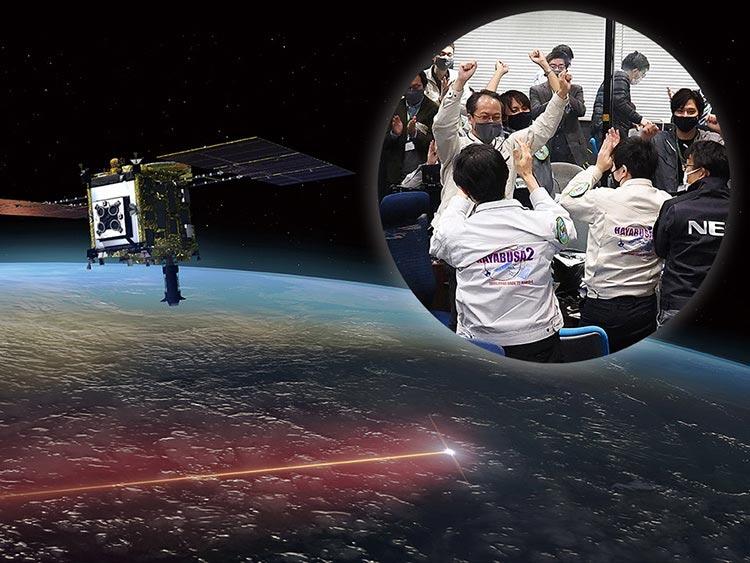
On December 6, 2020 the Hayabusa2 asteroid probe completed its six-year journey and delivered a capsule filled with asteroid material to Earth. The bold challenge, which included collecting subsurface material from an asteroid for the first time in humankind's history, was a total success. In marked contrast to the first-generation Hayabusa, which 10 years earlier had returned to Earth in a battered state after a mission fraught with difficulties, Hayabusa2's smooth 5.2-billion-kilometer journey capitalized on that past experience to display Japan's high-level exploration technology to the world. Forming a backdrop to that were the strenuous efforts of the mission management team, which consistently rose to the challenges it faced by calmly assessing the circumstances and refining their skills accordingly.
This time let's ensure it's not made into a movie
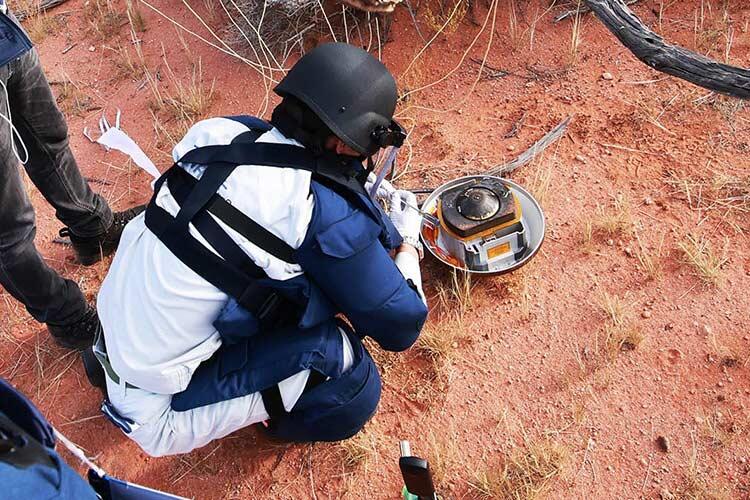
"Well, I'd give it 10,000 points."
A press briefing was held on December 6, the day the capsule was recovered. Japan Aerospace Exploration Agency (JAXA) Professor Yuichi Tsuda, who served as Hayabusa2's project manager, was asked by a newspaper journalist how he would score the six-year mission out of 100. This was his cheerful and immediate reply.
Hayabusa2 is the successor model to the first-generation Hayabusa, which in 2010, collected asteroid material and returned it to Earth for the first time in the world. Hayabusa2 leveraged Hayabusa's basic design and added significant improvements. It landed on a different asteroid known as Ryugu, collected material from the asteroid's surface and subsurface, and then carried it back to Earth.
When interviewed by Science Window, Professor Tsuda appeared relieved. "The team used to say, 'This time let's make sure it's not made into a movie' as if it was a mantra. Since this mission was not accompanied by any dramas that compelled us to overcome seemingly-impossible problems, it would be hard to make a movie out of it. And so far, aside from a CG work there has been no talk of any movies," he explained.
The first-generation mission faced a myriad of problems, to the point where the management team were starting to wonder what could possibly go wrong next. The attitude control system failed, there was a fuel leak and communication blackout, and all four of the ion engines for accelerating the probe failed... Although Hayabusa recovered material from the Itokawa asteroid, it only recovered a minute amount, partly because a bullet that was supposed to strike the asteroid surface misfired. The probe's return to Earth, which at one point appeared hopeless, was accomplished through the sheer persistence of the mission management team. The sight of the probe burning up as it entered Earth's atmosphere at the end of the mission stirred the nation's emotions and made such a fuss that three movies were released about the story. The nonetheless significant achievements of the first-generation's mission are even discussed in junior high-school and high-school textbooks.
Lowering robot and collecting material--an all-out effort that lasted one year and five months
The steps in Hayabusa2's mission can be broadly summed up as follows.
Hayabusa2 departed from JAXA's Tanegashima Space Center (Kagoshima Prefecture) aboard an H2A rocket in December 2014. Following a "swing by" that utilized Earth's gravitational pull to accelerate and alter its trajectory, it arrived at Ryugu in June 2018. It carried out constant monitoring of the asteroid's terrain, gravity and other features, and lowered JAXA's small MINERVA-II1 robot and MASCOT, which was developed by Germany and France, onto the surface one after the other. Both devices moved about by "hopping," and sent photographs of the surface and observation data back to Earth.
The task of collecting asteroid material, which was the climax of the mission, took place twice. In February 2019, Hayabusa2 landed near the asteroid's equator and fired a bullet from the body of the probe in order to stir up surface material and collect it. Following that, in April a device was decoupled from the probe and detonated to create an artificial crater. The subsurface material that was exposed as a result of this process was collected in July.
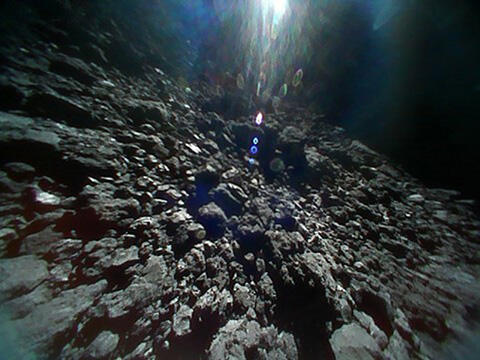
Hayabusa2 left Ryugu in November 2019. The return journey also went smoothly, and on December 6, 2020, it dropped its capsule onto an area of desert in Australia. A careful examination will have to be carried out to determine how much material it was actually able to recover, but it is believed to be an amount that significantly exceeds the minimum of 100 milligrams that the team had been anticipating.
Incidentally, MINERVA-II2, another small robot that was developed by an alliance of Japanese universities, was unable to carry out its experiments as planned due to a malfunction, but it was nevertheless put into orbit above Ryugu and proved useful for gathering detailed gravitational measurements, for example.
Grappling with the daunting Ryugu
Looking back at Hayabusa2's mission in this way makes it seem as if everything went off without a hitch, but in fact Ryugu proved to be hugely daunting adversary.
The images that the probe sent back when it arrived at Ryugu were greeted with dismay by all the team members assembled in the control room in Sagamihara City. That is because the entire surface of the asteroid was covered in rocks, and there was no sign whatsoever of level ground where the probe could land safely. "Initially we thought we would find somewhere if we looked closely, but after one or two weeks had passed, we were aghast, and concluded that we did not stand a chance," Professor Tsuda explains. If the team pushed ahead with the landing and Hayabusa2 struck a rock, it could end up damaging the probe and putting its return journey at risk.
Researchers and others had believed that asteroids always had some degree of level ground, and that Ryugu too would have a level area of around 100 square meters. On that basis, Hayabusa2 had been designed to have a landing accuracy of around 50 meters. Faced with this difficulty, Professor Tsuda looked bewildered at a press briefing held at the time. "Ryugu is baring its fangs at us," he stated.
In light of this situation, the initial collection of material, which had been expected to take place in October 2018, was postponed. While searching for a sufficiently-sized area of level ground, the team also decided to explore the limits of what Hayabusa2 was actually capable of doing, not just what it was designed to be capable of. The team not only undertook a detailed analysis of the probe's capabilities through descent drills, they also took into account that Ryugu's gravity differed slightly from place to place, and that the body of the probe could be tilted to ensure it avoided colliding with rocks. The team came up with a number of detailed ideas.
Perhaps the biggest refinement--and one that ultimately led to success--was the way the small tools known as the "target markers" were used. Target markers are dropped to the asteroid's surface as landmarks that are useful for determining position. Initially, the plan for the first landing called for Hayabusu2 to make its descent while following the falling markers down. This plan was revised, however, and it was decided to drop the markers to the surface in advance and capture their descent on camera, thus making it possible to confirm position more precisely. This approach was to be put into practice and tested from the second and any subsequent landings, but the team decided to use it to accurately target a landing spot.
Through this brainstorming, ultimately it was confirmed that Hayabusa2's landing accuracy could be improved to 2.7 meters, well above the landing accuracy it was designed to have. Meanwhile, with some difficulty the team was able to find a smooth location with a radius of 3 meters, or above the new landing accuracy figure, from among a number of candidate sites.
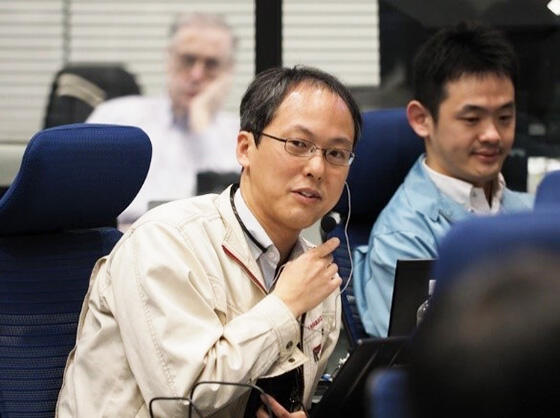
Then came the first landing. Hayabusa2 mobilized all its equipment perfectly and took images of sand grit being tossed up that it sent to the control room 340-million kilometers away. This was the moment when Hayabusa2 put to rest the issues faced by the first-generation mission, which had been unable to fire its bullet, and it was then that humankind established a new exploration method for low-gravity celestial bodies.
Professor Tsuda's bright voice reverberated through the press briefing venue: "Today, the hands of humankind reached a new small star." According to detailed analysis carried out subsequently, Hayabusa2's degree of error at the actual landing site was just one meter.
Rise to the challenge, but do not gamble
The next challenge was to collect subsurface material. Material on the asteroid's surface is "weathered" as a result of being affected by sunlight and cosmic rays (atomic particles that fly about in outer space). Subsurface material, on the other hand, escapes this weathering and is preserved in its ancient state. Conceivably, this will prove useful in researching the history and weathering phenomena of the solar system. The first part of the plan called for a "projectile device" to be separated off from the probe and detonated to create an artificial crater. Hayabusa2 would then land to collect the subsurface material that would be exposed and scattered about as a result of that process.
Creating the crater required sophisticated maneuvering of the probe and its equipment. After releasing the projectile device, the probe would take refuge in Ryugu's shadow to prevent the damage caused by the projectile device's explosion from reaching it. The projectile device would be detonated above the surface, and a copper plate would be thrown forth to strike the surface and form a crater. There was only one projectile device, so there was only one shot at it. On top of that, the explosion was on a timer, so once the projectile device left the probe the detonation could not be stopped. If by some chance Hayabusa2 was slow to take refuge, it would likely be damaged as a result of colliding with the material thrown up during the crater formation.
Ultimately, the work proceeded perfectly and a crater with a diameter of around 10 meters was created in the targeted location. A camera that had split off from the probe also successfully captured the moment when the material was thrown up. The meticulous technique that was employed to realize this task astounded the world. In the subsurface material collection that followed, Hayabusa2's landing was just 60 centimeters off target, improving even further on the accuracy of the first landing.
Reflecting on Hayabusa2's approximately one year and five months at Ryugu, Professor Tsuda emphasizes that "In rising to the challenges of taking on an asteroid, we used every idea that we could come up with, but there was no hit or miss gambling involved. We always ensured safety and made sure that even if the mission failed, for example, the probe would not be lost.
Searching for the history of the solar system, Earth and life
What was Hayabusa2's scientific goal to begin with? There are around one million known asteroids in the solar system, and the majority of them lie within the "asteroid belt" between Mars and Jupiter. However, some asteroids such as Itokawa and Ryugu draw close to Earth's orbital path (its orbit around the sun), making it easy for probes to travel to and from them from Earth. Hayabusa and Hayabusa2 were conceived on that basis.
When Earth and other planets were formed, they repeatedly collided with celestial bodies, and the material on them was altered as a result of being temporarily subjected to high temperatures. By comparison, asteroids' properties have not undergone any large-scale changes, and it is conceivable that the state they were in when the planets were formed is comparatively well preserved. If that material can be collected and directly analyzed, it will likely provide powerful clues for understanding the history of the solar system.
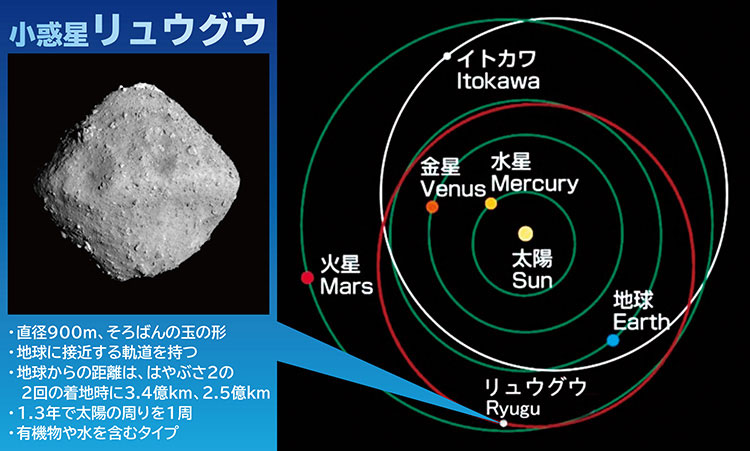
Based on observations carried out from Earth, Ryugu is classified as a type of asteroid containing the organic matter and water that are essential to life. It is regarded as very likely that when celestial bodies of this type collided with Earth long ago, they brought with them the raw materials for the Earth's life and seawater. Hayabusa2 was charged with a mission founded on humankind's primordial curiosity--namely, to search for the roots of life by verifying this theory.
"Exactly what sort of organic matter will the material that Hayabusa2 gathered contain?" ponders JAXA Associate Professor Makoto Yoshikawa, who served as Hayabusa2's mission manager. He also emphasizes that, "The outcomes of science rarely appear in real time, while an exploration is taking place. Our focus is on what will be learned once the capsule returns."
It will also contribute to research on preparing to deal with celestial bodies on track to collide with Earth
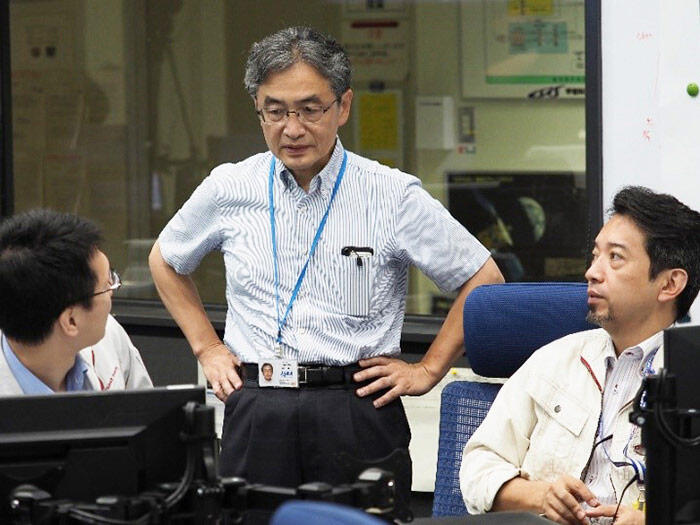
"Science is not the sole purpose of Hayabusa2's probe," adds Professor Yoshikawa, who is also a leading researcher on "planetary defense," or preparing for the possibility of a celestial body threatening to strike Earth. It is widely known that 66 million years ago a celestial body collided with Earth and rendered dinosaurs extinct, but the risk of such a body striking Earth is always present. In 2013, a meteorite with a diameter of around 17 meters fell in Chelyabinsk Oblast, Russia. A large number of people were injured as a result of the damage it caused to buildings and glass across a wide area.
Of the celestial bodies that are approaching Earth, some with diameters of roughly a kilometer or more have already been discovered, but even smaller bodies with diameters of around 20 meters or more would likely cause substantial damage. As for what will be done if a large body is found that is on track to strike Earth, Professor Yoshikawa explains that "With our current technologies the only conceivable option would be to preemptively crash an object like a probe into it to alter its trajectory. Studying Ryugu's makeup will thus also be important in terms of considering ways of avoiding celestial collisions."
Once Hayabusa2 had delivered its capsule to Earth, it used its remaining fuel to embark on its next journey. It will traverse another asteroid, known as 2001CC21, in 2026, and in 2031, will arrive at the 1998KY26 asteroid to carry out a probe. This time, it will not return to Earth. 1998KY26 has a diameter of approximately 30 meters, and according to Professor Yoshikawa celestial bodies of this size strike Earth once every 100-200 years. This probe will therefore be of considerable interest from a planetary defense perspective also.
For the very reason that we faced a tough adversary
What did Hayabusa2 teach us? "The Art of War," a work from China's Spring and Autumn Period (approx. 5th century BC) by Sun Tzu, contains the famous phrase "If you know the enemy and know yourself, you need not fear the result of a hundred battles." It suggests that if you have a solid grasp of the circumstances of your enemies and your allies alike, you will not be defeated no matter how many times you fight.
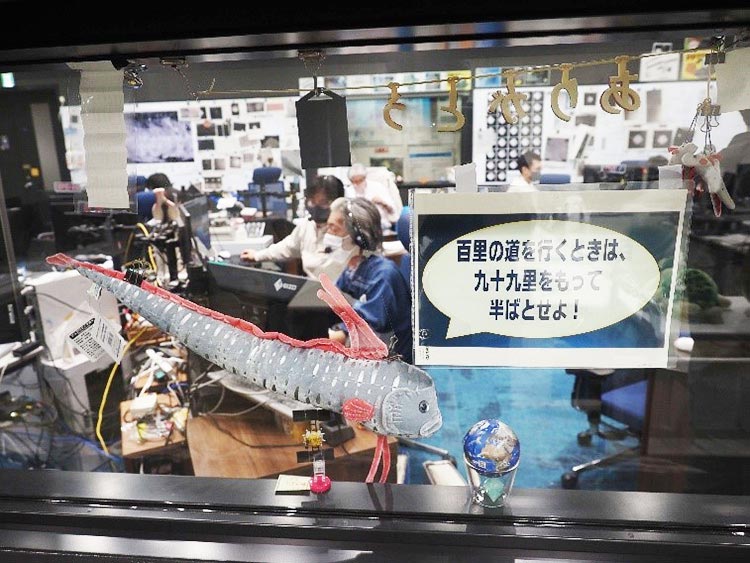
When the "Art of War" quote is put to Professor Tsuda, he reflects that "The more I knew about Ryugu, the more I realized that it would not be possible to tackle such an adversary using our existing knowledge. For the very reason that we faced a tough adversary, we needed to assess our potential and ask ourselves if we were capable of more. In some cases, also, we reached our limits and concluded that we could indeed do no more than we had. I think we really did carry out the mission in line with the Sun Tzu quote."
The Hayabusa2 team adopted the motto "Let's ensure it's not made into a movie." Looking back, however, perhaps the first-generation Hayabusa and Hayabusa2 should conversely be thought of as a continuation of the same story. It certainly does appear that the story of this mission team's all-out effort and success--and Hayabusa2's subsequent return--are the very makings of a movie.
Prof. Yuichi Tsuda
Professor, Institute of Space and Astronautical Science (ISAS) at Japan Aerospace Exploration Agency (JAXA); Project Manager for the Hayabusa2 asteroid probe
Professor Tsuda completed a doctoral program majoring in the aerospace engineering at the Graduate School of Engineering, the University of Tokyo in 2003. After working as an assistant professor at JAXA, as a visiting researcher at University of Michigan and University of Colorado Boulder in the U.S., as an associate professor at JAXA and in other roles, he was made a professor at JAXA in 2020.
Professor Tsuda's research themes include space engineering, astronautical mechanics, and solar system exploration.
Dr. Makoto Yoshikawa
Associate Professor at JAXA's Institute of Space and Astronautical Science (ISAS); Mission Manager for Hayabusa2
Professor Yoshikawa completed a doctoral program majoring in astronomy at the Graduate School of Science, the University of Tokyo in 1989. After working as a research fellow at the Japan Society for the Promotion of Science (JSPS), as a senior researcher at the then-Communications Research Laboratory of the Ministry of Posts and Telecommunications, as an assistant professor at ISAS (at that time under the jurisdiction of the Ministry of Education, Culture, Sports, Science and Technology) and in other roles, as a result of organizational reform he was made an assistant professor (now an associate professorship) at JAXA in 2003.
Professor Yoshikawa's research themes include celestial mechanics, planetary exploration and planetary defense.
Original article was provided by the Science Portal and has been translated by Science Japan.




